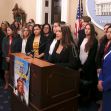According to the Equal Employment Opportunity Commission, the #MeToo movement has led to a dramatic increase in class actions related to sexual abuse. Of course, even before the start of the #MeToo era, massive claims, such as the one involving the Catholic Church, exposed just how pervasive such misconduct is in modern society.
One of the most recent sex abuse-related class-action claims just led to a $73 million settlement. The case involved a former UCLA gynecologist who allegedly abused many of his over 6,600 patients. The complaint included seven named patients, and thousands of others may also recover some of the settlement funds. Following the filing of the lawsuit, over 200 women reported experiencing abuse by Dr. James Heaps. Heaps, who is also defending against criminal charges related to the abuse claims, maintains his innocence. UCLA admits that it began investigating claims in 2017, although it appears that the university received earlier reports of misconduct by Heaps.
What Allegations Did Victims Make Against Dr. Heaps?
The allegations against Dr. Heaps include inappropriate sexual comments, sexual touching during exams, not using gloves, and using an ultrasound probe to simulate intercourse. Some other former patients spoke out in defense of Heaps, stating that he had never engaged in any inappropriate conduct with them. The allegations include those made by patients treated by Heaps between the 1980s and 2018, indicating that the doctor may have been abusing patients for decades.
Is Dr. Heaps Going to Prison?
The civil case against UCLA is separate from criminal charges resulting from some of the same allegations. Heaps has pled not guilty to all charges and denied engaging in any wrongful conduct with his patients. The criminal case is still underway, with a total of at least twenty charges currently pending. Those charges are related to alleged instances of abuse that occurred between 2011 and 2018. Some counts include sexual exploitation of patients and sexual battery by fraud. If convicted, the doctor could face more than 60 years in prison.
Why is UCLA Responsible for the Alleged Abuse?
While the plaintiffs accuse Heaps of perpetrating the abuse, UCLA is liable for its failure to protect patients. According to allegations, the university neglected to act following abuse reports from 2014, 2015, and 2017. UCLA did not terminate Heaps or suspend him, and even when they began to investigate the doctor, they allowed him to continue examining patients. Critics state that the university attempted to brush the wrongful conduct under the rug to protect its reputation at patients' expense. Following the settlement, UCLA claims that it will implement updated policies related to abuse and harassment investigations and that there will be a formal chaperone policy for medical examinations. The school will also engage in more training and work to ensure patients can access information about reporting abuse.
What Will Victims Recover from the Fund?
Women who come forward will receive a minimum of $2,500 in compensation. The allegations may include either harassment or assault. A panel of experts will review the allegations made by each woman and determine the amount of compensation due. Depending on the abuse, the plaintiffs could seek hundreds of thousands of dollars in compensation.
Many former patients filed their own separate lawsuits against the doctor and UCLA outside of the class action. Governor Gavin Newsom approved a measure that will allow for abuse victims to file their claims throughout 2021, even in cases where the statute of limitations would otherwise have prevented such lawsuits.
Other Class-Action Lawsuits Regarding Sexual Abuse
This lawsuit is not unique. Recently, the University of Southern California reached a $215 million settlement related to sexual abuse allegedly committed by Dr. George Tyndall, another former gynecologist. In that case, there are potentially 18,000 women who have claims against the doctor.
Of course, there are several other recent high-profile massive class-action lawsuits concerning sex abuse claims, including ones against the Catholic Church and the Boy Scouts.
When are Class Actions Used in Sex Abuse Cases?
To have a class-action lawsuit, it is necessary that there is a live claim in dispute and that the representative named in the claim has a live claim and is a member of the class which he or she represents. There must also be objective identifying factors that will determine who is a member of the class.
Class actions apply when there is a large group of plaintiffs with similar claims against the defendant. In most cases, at least 40 members should be in the class. The outcome of the claims of the representative will determine that of the class. The class representatives and the attorneys involved must not have conflicts of interest in representing the class members.
Are Class Actions the Right Way to Handle Sex Abuse Claims?
There are some benefits to the use of class actions in these cases. The large group of class members can help the victims gain the strength needed to challenge a large and powerful adversary. These lawsuits also create an incentive for experienced attorneys to take on these matters. It might be that these large class-action lawsuits are also an effective way to push for institutional changes. Large organizations are now being forced to look at how their practices perpetuate, conceal, and mishandle sexual abuse. Perhaps the financial pain inflicted by these large settlements and the bad press for the universities and other organizations will lead to more caution and greater transparency.






